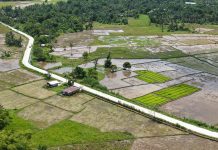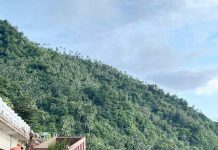TACLOBAN CITY – Leyte Governor Leopoldo Dominico Petilla said that there are areas in the province which could be planted for bamboos.
In fact, about 7,000 hectares along the Binahaan River could be planted for bamboos, the governor said.
Lately, the governor has been encouraging farmers in the province to plant bamboos to help increase their income saying there is now a huge demand of bamboos in the world market.
Petilla, who recently led in the oath-taking of officials of a bamboo farmers association in San Isidro, Sta. Fe town, said that aside from generating more income for the farmers, bamboo planting could help save the province from climate change.
“We may come to that part but we have to produce first before we market our province on bamboo production. It’s hard to sell our province for a product that is not existence. The key to that is to enhance the skills and knowledge of our people on bamboo production,” Gov. Petilla said.
“Before we also market our bamboo abroad, we also need to examine what are their quality standards. We need to know if we can meet their standard and if we see that we can meet it then we will produce the quality of bamboo according to that standard so that we can export,” he added.
Demands of bamboos continue to rise making it a multi-billion export industry in global market, according to Senator Cynthia Villar who visited China last June.
“Bamboo is an alternative source of income to farmer,” Villar said citing that based on her visit in China, a farmer can earn as much as P1.5 million a year on a one-hectare bamboo plantation which is good for poverty reduction campaign of Philippine government.
“I am supporting bamboo industries, primarily because bamboo is a cash crop for Filipino farmers and can be a good source of income and livelihood of poor communities, particularly in rural areas in our country,” Villar added.
The National Greening Program, which the Department of Environment and Natural Resources (DENR) implement, mandates that 20% of the target land for reforestation must be planted with bamboo.
Promoting bamboo as alternative crops in rehabilitating mined sites is being pushed by the DENR according to Secretary Roy Cimatu.
“Demand of bamboo worldwide including China is huge. But before we can plant it we need to test first if what variety is suitable on that area,” Sec Cimatu said.
He added that while the DENR is in charge of bamboo production, the Department of Trade and Industry will handle its marketing.
From home decors and furniture, the use of bamboo had evolved to industrial and construction usage. The leaves of bamboos are also known to absorb more than 100 times of carbon monoxide than that of the ordinary tree.
In Tacloban, engineered bamboo was introduced as material for housing construction after the devastation of super typhoon ‘Yolanda’ in 2013.
Hilti Foundation (Base Balay Inc.), a partner of Operation Blessing, brought the construction concept in the city for the building of 324 housing units in the 1.5 hectare land housing projects in Palanog for families from Barangays 89 and 90. (ROEL T. AMAZONA



